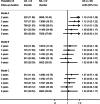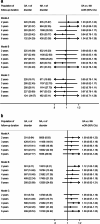Association between general anesthesia for cesarean delivery and subsequent developmental disorders in children: a nationwide retrospective cohort study
- PMID: 40001119
- PMCID: PMC11863964
- DOI: 10.1186/s12916-025-03886-6
Association between general anesthesia for cesarean delivery and subsequent developmental disorders in children: a nationwide retrospective cohort study
Abstract
Background: Exposure to general anesthetics (GA) in early childhood is associated with developmental disorders. However, few studies have addressed in-utero exposure to anesthetics during delivery and subsequent developmental disorders in the offspring. This study aimed to investigate whether GA for cesarean delivery is associated with developmental disorders in children.
Methods: Using data retrieved from the National Health Insurance Research Database linked to the Birth Reporting Database and the Maternal and Child Health Database between 2015 and 2020, this nationwide retrospective cohort study compared the incidence of developmental disorders following cesarean delivery under GA with that under neuraxial anesthesia (NA). Developmental disorders were diagnosed using the corresponding International Classification of Diseases codes traced 2-6 years after delivery.
Results: After excluding twins, children born with congenital anomalies or diseases and those with missing data, 325,309 eligible singleton pregnancies delivered through cesarean section under either GA or NA were enrolled. Of the total, 6973 of them were delivered under GA and 318,336 under NA. After propensity score-based fine stratification weighting with a model including age, socioeconomic deprivation, gestational status, infant sex, preterm delivery, low birth weight, and cesarean delivery duration, children delivered under GA were associated with a higher risk of developmental disorders diagnosed within 2 years (adjusted odds ratio [aOR], 1.17; 95% confidence interval [CI], 1.07-1.28), 3 years (aOR, 1.12; 95% CI, 1.04-1.21), and 4 years (aOR, 1.12; 95% CI, 1.04-1.21) compared with those under NA. This association was no longer present when the confounding effect of Apgar scores was included in the propensity-score model.
Conclusions: GA for cesarean delivery may be associated with developmental disorders diagnosed within 2-4 years after birth manifested through poorer 1- and 5-min Apgar scores. There is no evidence of a direct relationship between GA-related neurotoxicity and subsequent developmental disorders.
Keywords: Anesthesia; Apgar scores; Developmental disorders; Neurotoxicity.
© 2025. The Author(s).
Conflict of interest statement
Declarations. Ethics approval and consent to participate: This study was exempt from full review by the Institutional Review Board of Chi Mei Medical Center (11105-E02), and a waiver of the requirement for obtaining patient consent was granted due to the use of anonymized data. Consent for publication: Not applicable. Competing interests: The authors declare no competing interests.
Figures



Similar articles
-
Anesthesia for cesarean delivery and subsequent depression: A nationwide retrospective cohort study.J Affect Disord. 2024 Nov 1;364:108-115. doi: 10.1016/j.jad.2024.07.147. Epub 2024 Aug 5. J Affect Disord. 2024. PMID: 39111347
-
Perinatal outcome of preterm cesarean section in a resource-limited centre: a comparison between general anaesthesia and subarachnoid block.Niger J Clin Pract. 2014 Sep-Oct;17(5):613-8. doi: 10.4103/1119-3077.141428. Niger J Clin Pract. 2014. PMID: 25244273
-
Perinatal outcome of emergency cesarean section under neuraxial anesthesia versus general anesthesia: a seven-year retrospective analysis.BMC Anesthesiol. 2024 Jan 19;24(1):33. doi: 10.1186/s12871-024-02412-0. BMC Anesthesiol. 2024. PMID: 38243205 Free PMC article.
-
Emergency delivery in pregnancies at high probability of placenta accreta spectrum on prenatal imaging: a systematic review and meta-analysis.Am J Obstet Gynecol MFM. 2024 Oct;6(10):101432. doi: 10.1016/j.ajogmf.2024.101432. Epub 2024 Jul 26. Am J Obstet Gynecol MFM. 2024. PMID: 39069207
-
Assessment of placenta accreta spectrum at vaginal birth after cesarean delivery.Am J Obstet Gynecol MFM. 2023 Oct;5(10):101115. doi: 10.1016/j.ajogmf.2023.101115. Epub 2023 Aug 3. Am J Obstet Gynecol MFM. 2023. PMID: 37543142
References
-
- Mhyre JM, Sultan P. General anesthesia for cesarean delivery: occasionally essential but best avoided. Anesthesiology. 2019;130(6):864–6. - PubMed
-
- Olutoye OA, Baker BW, Belfort MA, Olutoye OO. Food and drug administration warning on anesthesia and brain development: implications for obstetric and fetal surgery. Am J Obstet Gynecol. 2018;218(1):98–102. - PubMed
MeSH terms
Grants and funding
LinkOut - more resources
Full Text Sources
Medical

